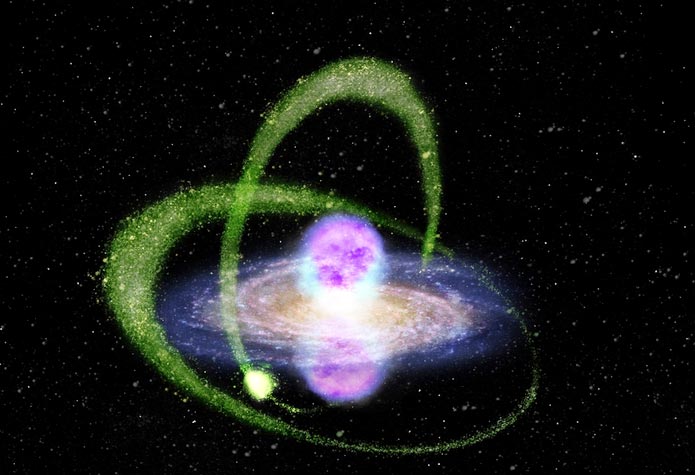Gamma rays from neighboring galaxy related to millisecond pulsars

A small satellite galaxy of the Milky Way – called the Sagittarius dwarf galaxy – has been observed from Earth through giant lobes of gamma radiation (the so-called Fermi bubbles). Although the dwarf galaxy is stuffed with dark matter, this is unlikely to be the cause of the observed emission.
Image: O. Macias
A team of researchers, including UvA physicists and astronomers, has studied gamma rays caused by the Sagittarius Dwarf, a small neighbouring galaxy of our Milky Way. They showed that all the observed gamma radiation can be explained by millisecond pulsars, and can therefore not be interpreted as a smoking gun signature for the presence of dark matter. The results were published in Nature Astronomy this week.
The center of our galaxy is blowing a pair of colossal bubbles of gamma radiation (the magenta structures in the image above) that span a whopping 50,000 light-years across. Discovered with the Fermi Gamma-ray Space Telescope about a decade ago, the source of this hourglass-shaped phenomenon remains unclear.
These Fermi bubbles are patched with a few enigmatic substructures of very bright gamma-ray emission. One of the brightest spots, the so-called Fermi cocoon, is found in the southern lobe (magnified inset in the figure below) and was originally thought to be due to past outbursts from the Galaxy’s supermassive black hole.
A team including Oscar Macias at the University of Amsterdam & Kavli IPMU and Roland Crocker at the Australian National University analyzed data from the GAIA and Fermi space telescopes to reveal that the Fermi cocoon is actually due to emission from the Sagittarius dwarf galaxy.
This satellite galaxy of the Milky Way is seen through the Fermi bubbles from our position on Earth (see first figure). Due to its tight orbit around our galaxy and previous passages through the galactic disk, it has lost most of its interstellar gas and many of its stars have been ripped from its core into elongated streams.
Given that the Sagittarius dwarf is completely quiescent — it has no gas, and no stellar nurseries — there are only a few possibilities for its gamma-ray emission, including (1) a population of unknown millisecond pulsars or (2) dark matter annihilations.
Millisecond pulsars are the remnants of certain types of stars, significantly more massive than the Sun, that are in close binary systems, and now blast out cosmic particles as a result of their extreme rotational energies. The electrons fired by millisecond pulsars collide with low-energy photons of the Cosmic Microwave Background, propelling them to become high-energy gamma radiation.
Crocker, Macias and collaborators have convincingly demonstrated that the gamma-ray cocoon is explained by millisecond pulsars in the Sagittarius dwarf, and that the dark matter hypothesis is strongly disfavoured. This discovery sheds light on millisecond pulsars as efficient accelerators of highly energetic electrons and positrons. It also suggests that similar physical processes could be ongoing in other dwarf satellite galaxies of the Milky Way. This is highly significant because dark matter researchers have long believed that an observation of gamma rays from a dwarf satellite would be a smoking gun signature for dark matter annihilation.
This study compels a reassessment of the high energy emission capabilities of quiescent stellar objects, such as dwarf spheroidal galaxies, and their role as prime targets for dark matter annihilation searches.
Journal: Nature Astronomy
DOI: 10.1038/s41550-022-01777-x
Article Title: Gamma-ray emission from the Sagittarius dwarf spheroidal galaxy due to millisecond pulsars
Article Publication Date: 5-Sep-2022
Media Contact
Nick Beston
Universiteit van Amsterdam
n.r.beston@uva.nl
Office: 0031-205-252-695
All latest news from the category: Physics and Astronomy
This area deals with the fundamental laws and building blocks of nature and how they interact, the properties and the behavior of matter, and research into space and time and their structures.
innovations-report provides in-depth reports and articles on subjects such as astrophysics, laser technologies, nuclear, quantum, particle and solid-state physics, nanotechnologies, planetary research and findings (Mars, Venus) and developments related to the Hubble Telescope.
Newest articles

Innovative 3D printed scaffolds offer new hope for bone healing
Researchers at the Institute for Bioengineering of Catalonia have developed novel 3D printed PLA-CaP scaffolds that promote blood vessel formation, ensuring better healing and regeneration of bone tissue. Bone is…

The surprising role of gut infection in Alzheimer’s disease
ASU- and Banner Alzheimer’s Institute-led study implicates link between a common virus and the disease, which travels from the gut to the brain and may be a target for antiviral…

Molecular gardening: New enzymes discovered for protein modification pruning
How deubiquitinases USP53 and USP54 cleave long polyubiquitin chains and how the former is linked to liver disease in children. Deubiquitinases (DUBs) are enzymes used by cells to trim protein…


